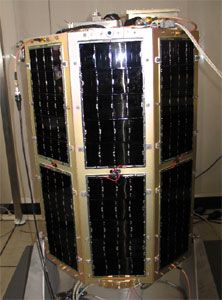
Home - Search - Browse - Alphabetic Index: 0- 1- 2- 3- 4- 5- 6- 7- 8- 9
A- B- C- D- E- F- G- H- I- J- K- L- M- N- O- P- Q- R- S- T- U- V- W- X- Y- Z
Midstar
 Midstar 1 Credit: Manufacturer Image |
Status: Operational 2007. First Launch: 2007-03-09. Last Launch: 2007-03-09. Number: 1 . Gross mass: 120 kg (260 lb). Height: 0.10 m (0.32 ft). Diameter: 0.19 m (0.62 ft).
The aim of the UN Naval Academy's Midshipman Space Technology Applications Research (MidSTAR) Program was to develop a general-purpose satellite bus capable of supporting a variety of space missions by easily accommodating a wide range of space experiments and instruments.
The integration of the experiments with the satellite bus could be accomplished with minimal changes to the satellite bus design. MidSTAR was intended to be a relatively low-cost, quick response platform accommodating small payloads approved by the Department of Defense (DoD) Space Experiments Review Board (SERB) and launched through the DoD Space Test Program (STP).
MidSTAR satellites were of two types. MidSTAR mod 1 was designed for use on the Expendable Secondary Payload Adaptor (ESPA) Ring developed by Air Force Research Laboratory (AFRL) for placement on Delta IV or Atlas V expendable launch vehicles. MidSTAR mod 2 was to have been designed for deployment from the Space Shuttle via the Canister All Payload Ejection (CAPE) system developed by AFRL.
The baseline MidSTAR mission included a single spacecraft under the command and control of a single satellite ground station located at the Naval Academy in Annapolis, Maryland. The ground station forwarded downlinked data files to the Principal Investigators via the Internet. Secondary ground control was available through Naval Postgraduate School in Monterey California.
More at: Midstar.
| FUSE American ultraviolet astronomy satellite. FUSE carried four 0.35m far ultraviolet telescopes each with an ultraviolet high resolution spectrograph. Astronomy, Far-UV spectroscopy satellite built by Orbital Sciences Corporation (OSC) (Bus), Johns Hopkins University Applied Physics Laboratory (APL) (Instrument) for NASA, USA. Launched 1999. Used the MidStar. Launched 1999. |
| MidSTAR 1 Technology satellite for U.S. Naval Academy, USA. Launched 2007. Used Midstar-1 mod.1 bus. |
| MidSTAR 2 Technology satellite for U.S. Naval Academy. Used Midstar-1 mod.1 bus. |
Family: Technology, Technology satellite. Country: USA. Launch Vehicles: Atlas V, Atlas V 401. Launch Sites: Cape Canaveral, Cape Canaveral LC41. Agency: USN, USNA. Bibliography: 2.
1999 June 24 - . 15:44 GMT - . Launch Site: Cape Canaveral. Launch Complex: Cape Canaveral LC17A. Launch Pad: SLC17A. LV Family: Thor. Launch Vehicle: Delta 7320-10.
- FUSE - .
Nation: USA.
Agency: NASA Greenbelt.
Manufacturer: Germantown.
Class: Astronomy.
Type: X-ray astronomy satellite. Spacecraft Bus: MidStar.
Spacecraft: FUSE.
USAF Sat Cat: 25791 . COSPAR: 1999-035A. Apogee: 760 km (470 mi). Perigee: 745 km (462 mi). Inclination: 25.00 deg. Period: 99.90 min.
The Delta 3-m payload fairing was successfully jettisoned and the Far Ultraviolet Spectroscopic Explorer was placed in a 754 km x 769 km x 25.0 degree initial orbit. After separation the Delta second stage then a depletion burn and was left in a 182 x 915 km x 19.1 degree orbit from which it would quickly decay out of orbit. Checkout of FUSE in orbit was proceeding well as of July 1.
2007 March 9 - . 03:10 GMT - . Launch Site: Cape Canaveral. Launch Complex: Cape Canaveral LC41. Launch Pad: SLC41. LV Family: Atlas V. Launch Vehicle: Atlas V 401.
- Midstar 1 - .
Mass: 120 kg (260 lb). Nation: USA.
Agency: USN PGS.
Manufacturer: USNA.
Class: Technology.
Type: Navigation technology satellite. Spacecraft: Midstar.
USAF Sat Cat: 30773 . COSPAR: 2007-006B. Apogee: 498 km (309 mi). Perigee: 495 km (307 mi). Inclination: 46.00 deg. Period: 94.50 min.
MidSTAR-1 was flown under the DoD Space Test Program and carried the Internet Communications Satellite (ICSat) Experiment (SERB 2002-39) and the Configurable Fault Tolerant Processor (CFTP) Experiment for the Naval Postgraduate School (SERB 2002-34). Planned mission duration was two years.
Back to top of page
Home - Search - Browse - Alphabetic Index: 0- 1- 2- 3- 4- 5- 6- 7- 8- 9
A- B- C- D- E- F- G- H- I- J- K- L- M- N- O- P- Q- R- S- T- U- V- W- X- Y- Z
© 1997-2019 Mark Wade - Contact
© / Conditions for Use